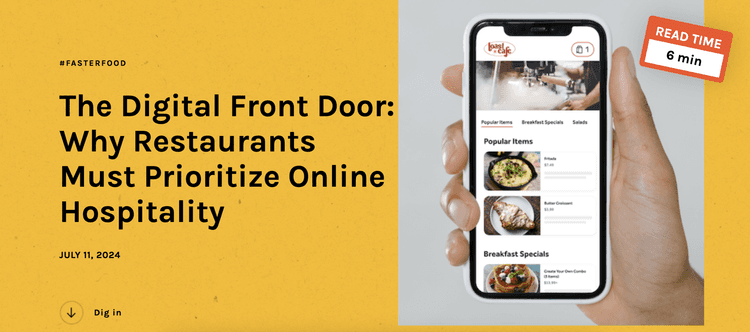Key Data Points:
- The global self-service kiosk market reached $34.4 billion in 2024 and is projected to hit $37.2 billion in 2025, with a CAGR of 10.9% through 2030 | Self-Ordering Kiosk Restaurant Statistics 2025 – Adoption & Customer Usage Data
- Self-service kiosks reduce total order time by nearly 40% | Self-Ordering Kiosk Restaurant Statistics 2025 – Adoption & Customer Usage Data
- 76% of kiosk-enabled restaurants reduced wait times, 67% increased check sizes, and 69% improved order accuracy | New eBook Reveals How Quick Service Restaurants Are Scaling Smarter with Handheld POS and Self-Service Kiosks |
The lunch rush at your favorite quick-service restaurant used to mean one thing: long lines and impatient customers checking their watches. But walk into most modern QSR locations today, and you’ll notice something different. Self-service kiosks have become the new front line, transforming how customers order and how restaurants operate.
The numbers tell a compelling story. Recent research reveals that 76% of kiosk-enabled restaurants have successfully reduced wait times, addressing what has historically been one of the biggest pain points in fast casual and quick-service restaurant operations. As the industry continues to evolve, self-service kiosks aren’t just a trendy addition—they’re becoming essential infrastructure for competitive restaurants.
The Economic Case for Kiosks Is Stronger Than Ever
The global self-service kiosk market demonstrates just how rapidly this technology is being adopted. After reaching $34.4 billion in 2024, the market is projected to hit $37.2 billion this year, with a compound annual growth rate of 10.9% expected through 2030. These aren’t just vanity metrics—they reflect a fundamental shift in how restaurants are investing in their operations.
Chris Allen, Research Director at RBR Data Services, puts it plainly: “With hospitality overheads continuing to skyrocket globally and minimum wage increases planned in many developed countries, restaurant chains of all sizes will introduce kiosks or expand existing rollouts as a way of rationalizing their operations and boosting transaction values.”
But the story goes beyond simple cost reduction. Restaurants are discovering that self-service kiosks deliver measurable improvements across multiple operational metrics that directly impact both the bottom line and customer satisfaction.
Three Key Benefits Driving Adoption
Dramatically Reduced Wait Times
The most immediate impact of self-service kiosks is speed. Research shows these systems reduce total order time by nearly 40%—a game-changing improvement during peak hours. When customers can walk up to available kiosks instead of waiting in a single queue, the entire flow of the restaurant improves.
This isn’t just about moving people through faster. Reduced wait times mean happier customers, higher table turnover, and the ability to serve more guests during critical lunch and dinner rushes without adding square footage or expanding the physical footprint.
Increased Check Sizes
Perhaps surprisingly to some operators, 67% of restaurants with kiosks report increased check sizes. The reason is straightforward: digital interfaces are excellent at suggesting add-ons, upgrades, and complementary items without the social pressure that sometimes makes customers hesitate to customize their orders with human cashiers.
Kiosks never forget to suggest dessert, never get too busy to mention limited-time offers, and present upsells in a visually appealing way that feels less like sales pressure and more like helpful suggestions. The result is more revenue per transaction without requiring additional labor.
Improved Order Accuracy
Order accuracy might be the most underrated benefit of self-service technology. With 69% of kiosk-enabled restaurants reporting improved accuracy, the impact extends beyond just getting orders right the first time. Fewer mistakes mean less food waste, fewer remakes, reduced customer service issues, and better overall guest experiences.
When customers input their own orders, see visual confirmations of their selections, and can review everything before finalizing, the chances of miscommunication drop dramatically. No more misheard special requests or confusion about modifications.
Why Restaurant Wait Times Matter More Than Ever
In today’s competitive dining landscape, wait times have become a critical differentiator. Customers have more choices than ever, and they’re increasingly willing to take their business elsewhere if service feels too slow. Social media amplifies both positive and negative experiences, meaning a reputation for long lines can spread quickly.
Self-service kiosks address this pain point while simultaneously freeing staff to focus on food preparation, quality control, and customer service for those who need assistance. The technology doesn’t replace human workers—it redeploys them to higher-value activities that genuinely require a human touch.
Choosing the Right Kiosk Solution
Not all self-service kiosks deliver the same results. The best solutions combine intuitive user interfaces that require minimal learning curve with enterprise-grade reliability that ensures consistent uptime during your busiest hours. Restaurant operators need QSR technology that integrates seamlessly with existing POS systems, supports their specific menu complexity, and provides the analytics to continuously optimize performance.
Modern kiosk solutions like Bite are designed specifically to deliver the outcomes that matter most: reduced wait times, increased revenue per order, and improved accuracy. With proven results across thousands of restaurant locations, the right kiosk platform becomes a strategic asset rather than just another piece of hardware.
The Future of Restaurant Operations
As the data makes clear, self-service kiosks have moved from experimental technology to operational necessity. The 76% of restaurants seeing reduced wait times, the 67% enjoying larger check sizes, and the 69% experiencing better order accuracy aren’t outliers—they’re the new standard for forward-thinking operators.
For restaurants still on the fence about adopting kiosk technology, the question isn’t whether to implement self-service ordering, but rather when and with which solution. The competitive advantages are too significant to ignore, and customers increasingly expect the option to order on their own terms.
In 2025 and beyond, cutting wait times isn’t just about speed—it’s about building a restaurant operation that meets modern customer expectations while creating a more sustainable and profitable business model.





